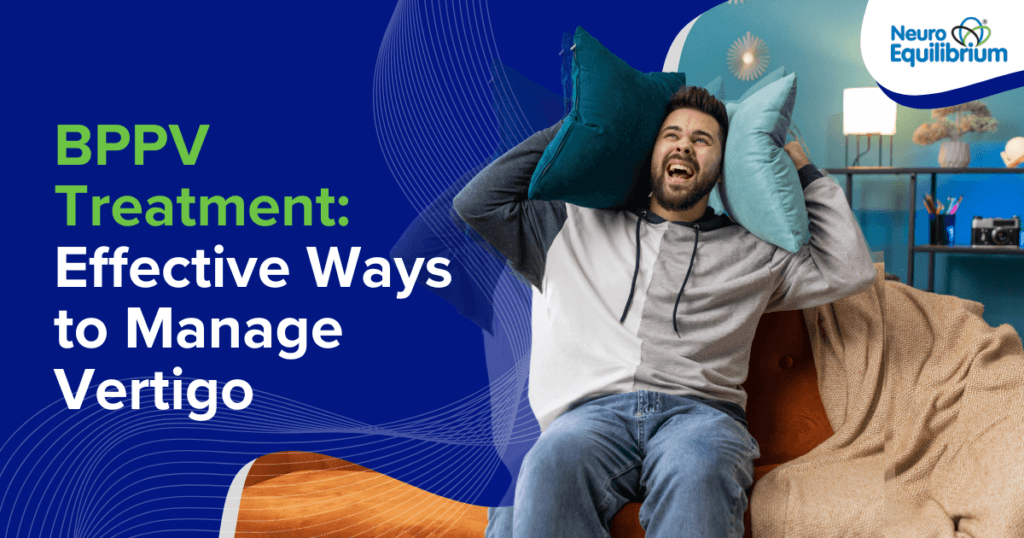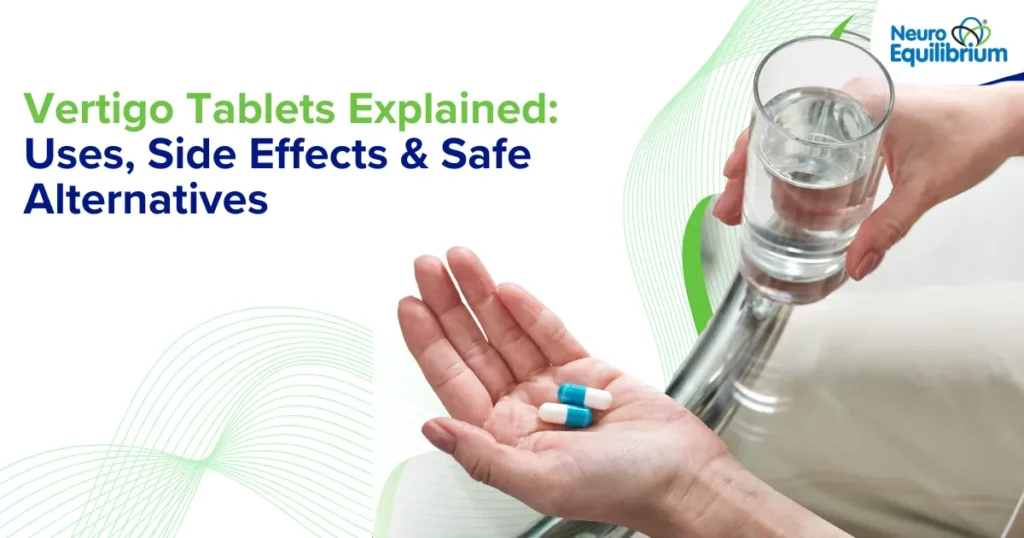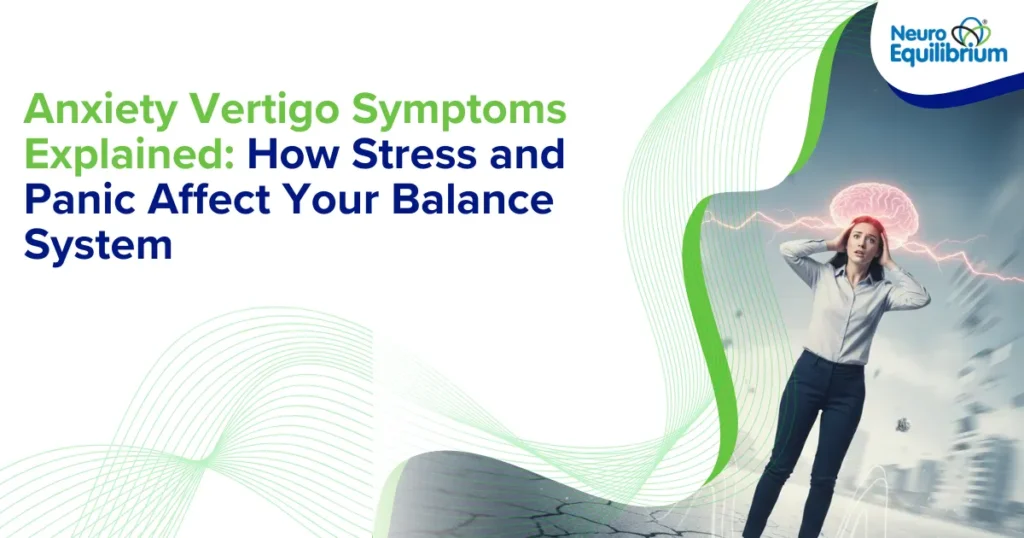Benign Paroxysmal Positional Vertigo (BPPV) often occurs as a cause of vertigo, as it produces spinning sensations along with physical instability and “chakkar” symptoms. BPPV is a mechanical condition of the inner ear that triggers brief episodes of vertigo due to crystal displacement, lasting less than one minute. Symptoms typically arise when a person performs head movements, including rising from bed, turning, and bending down. Many people often seek how to cure vertigo permanently, especially when these episodes start affecting daily life.
Causes of BPPV
Benign Paroxysmal Positional Vertigo (BPPV) happens when tiny crystals in the inner ear move out of place. It can occur without a clear trigger (primary BPPV) or due to certain conditions (secondary BPPV). Here are some factors that can increase the risk of developing BPPV:
- Head Injury: A hit to the head can cause the tiny inner ear crystals to move out of place.
- Long Periods of Bed Rest: Staying in bed for too long without movement can lead to crystal displacement.
- Ear Infections: Some ear infections may cause the crystals to shift.
- After Surgery: BPPV can sometimes develop after a surgical procedure.
- Migraines: People who experience migraines are more likely to develop BPPV.
- Vitamin D Deficiency: Low vitamin D levels may increase the risk of BPPV.
- Aging: As people get older, BPPV becomes more common and can increase the risk of falls.
Understanding these causes can help prevent and manage BPPV effectively.
Symptoms of BPPV
The main symptom of Benign Paroxysmal Positional Vertigo (BPPV) is vertigo, which feels like spinning, dizziness, or “chakkar.”
Here’s what you need to know about BPPV symptoms:
- What Triggers It? Vertigo usually happens when you move your head, like getting out of bed, turning over, or bending down.
- How Long Does It Last? The dizziness comes on suddenly but lasts only briefly—usually less than 30 seconds.
- What Causes It? Tiny crystals in the inner ear move out of place, affecting balance.
- Other Symptoms: You may also feel nauseous or even vomit during an episode.
BPPV can be uncomfortable, but it is treatable with simple head movements.

How BPPV is Diagnosed
Doctors diagnose Benign Paroxysmal Positional Vertigo (BPPV) using special tests that check how the tiny crystals in the inner ear move, a key step in managing bppv vertigo effectively.
Here’s how it works:
- Positional Testing: The doctor moves your head into specific positions to see if it triggers dizziness, which is essential in identifying bppv vertigo. This helps shift the misplaced crystals.
- Using Advanced Equipment: The tests work best with VNG (videonystagmography), which employs specialized cameras to monitor your eye movements and aids in finding the right Vertigo cure for each patient.
- Watching Eye Movements (Nystagmus): If specific head movements cause jerky eye movements (nystagmus), it tells the doctor where the crystals are and which type of bppv vertigo you have.
- Why Diagnosis Matters: BPPV is a common cause of vertigo, but it’s often misdiagnosed. A correct diagnosis is essential to choose the proper treatment and help you feel better faster, bringing you closer to a lasting Vertigo cure.
Repositioning Maneuvers for BPPV Treatment
The main goal of repositioning maneuvers is to move the tiny displaced crystals in the inner ear back to their correct position, helping to stop dizziness. It is important to identify the position of the displaced crystals to decide which maneuver would work best.
How These Manoeuvres Work
- The doctor guides your head and body through specific movements to replace the misplaced crystals back to where they belong.
- These movements help the crystals pass from the semicircular canals and return back into the utricle
Here are five basic types of maneuvers that are commonly used:
1. Epley’s Maneuver (Canalith Repositioning Maneuver)
Best for: Posterior Canal BPPV (the most common type)
Steps:
- Sit on a table with your legs extended.
- Your doctor turns your head 45 degrees toward the affected ear.
- You are quickly laid back so your head hangs slightly over the edge. Stay here for 30 seconds.
- Your head is then turned 90 degrees to the opposite side.
- Your body is rotated another 90 degrees in the same direction so you are facing downward.
- You slowly sit back up.
Symptoms might get worse briefly before improving.
2. Semont’s Maneuver (Liberatory Maneuver)
Best for: Posterior Canal BPPV (Alternative to Epley’s Maneuver)
Steps:
- Sit upright and turn your head 45 degrees away from the affected ear.
- Quickly lie down on your affected side, keeping your head turned upward.
- After 30 seconds, you are rapidly moved to the opposite side without changing head position.
- Stay there for 30 seconds, then sit back up.
Good for patients who can’t do Epley’s Maneuver.
Effective when crystals are stuck and don’t move easily.
3. Barbeque/Roll Maneuver
Best for: Horizontal Canal BPPV
Steps:
- Lie on your back. Now turn your head toward the affected ear.
- Turn your head 90 degrees back to the center.
- Turn your head another 90 degrees to face the unaffected ear.
- Roll onto your stomach, looking down.
- Turn again by 90degrees.
- Now return to a sitting position.
Works well for horizontal canal BPPV.
Needs careful execution for best results.
4. Zuma Maneuver
Best for: Horizontal Canal BPPV
Steps:
- Sit upright
- Quickly move into a side-lying position on the affected side.
- Stay in this position for 30–60 second
- Turn body to center.
- Turn the head to healthy side.
- Return to sitting position.
Which Maneuver is Right for You?
Since there are various types of BPPV, each one needs a specific maneuver for treatment. The right maneuver is chosen based on eye movements (nystagmus) triggered by certain head positions.
- Posterior Canal BPPV: Epley’s, Semont’s maneuver
- Horizontal Canal BPPV: Barbeque or Zuma Maneuver .
- Patients with Mobility Issues: Semont’s or Zuma Maneuver
Technology for Better Treatment
- Advanced Guidance Systems: Tools like NeuroEquilibrium’s 3D humanoid system help doctors accurately position a patient’s head during treatment, ensuring the crystals move correctly for the best results.
Home Remedies vs. Medical Treatment: What Works Best for BPPV?
When dealing with bppv vertigo, many people wonder whether home remedies can provide lasting relief or if medical treatments are necessary for a true Vertigo cure. Here’s a balanced comparison to help you decide what works best.
Home Remedies for BPPV Vertigo
Some people find temporary relief from bppv vertigo using home-based methods. These include:
- Self-performed Repositioning Maneuvers: Guided by online tutorials or after medical consultation, patients may attempt Epley’s Maneuver at home.
- Staying Active: Avoiding long periods of bed rest can prevent the worsening of symptoms.
- Vitamin D Supplementation: Low vitamin D levels are linked to a higher risk of BPPV episodes. Proper intake may help prevent recurrence.
- Hydration and Healthy Diet: Supporting inner ear health through adequate water intake and balanced nutrition.
While home remedies may provide some comfort, they typically do not guarantee a permanent Vertigo cure.
Medical Treatment for BPPV Vertigo
For most people, professional medical treatment offers a faster and more effective solution for bppv vertigo.
- Accurate Diagnosis: Advanced diagnostic tools like videonystagmography (VNG) help pinpoint the affected canal.
- Guided Repositioning Maneuvers: Doctors can perform techniques like the Epley, Semont, or Barbecue Roll maneuver with precision, improving success rates.
- Vestibular Rehabilitation Therapy (VRT): This personalized therapy helps address residual dizziness and supports long-term recovery.
What Works Best?
For a lasting Vertigo cure, medical treatments are generally more effective than home remedies. However, home care can support medical treatments and help prevent recurrence. Consulting a specialist is always recommended for accurate treatment of bppv vertigo.
Vertigo Exercises: Can Vestibular Therapy Help BPPV?
Vertigo exercises are an essential part of long-term management for bppv vertigo, especially for patients who continue to feel dizzy even after repositioning maneuvers. This is where Vestibular Rehabilitation Therapy (VRT) plays a crucial role.
How Vestibular Therapy Helps BPPV Vertigo
VRT is a targeted exercise program designed to:
- Recalibrate the brain’s response to balance signals.
- Improve stability and reduce dizziness.
- Prevent future vertigo episodes.
These vertigo exercises train the brain to adapt to new movement patterns and compensate for imbalances caused by bppv vertigo.
Key Vestibular Exercises
- Gaze Stabilization: Focus on a fixed point while moving your head to help retrain eye and balance coordination.
- Balance Training: Practice standing on different surfaces and performing controlled movements to improve stability.
- VR-based Vestibular Therapy: Immersive virtual environments can make exercises more engaging and enhance results.
Other Treatment Options
Medications alone do not provide a Vertigo cure or cure BPPV vertigo. If you are wondering how to cure vertigo permanently, it’s important to know that vestibular suppressants should not be taken for more than a few days, as they provide only temporary symptom relief.
Vestibular rehabilitation therapy (VRT) may be required in residual dizziness after the maneuver is performed. It consists of customized exercises to promote vestibular compensation and improve balance and stability. For those exploring how to cure vertigo permanently, VR-based vestibular rehab modules offer immersive environments and challenges, making rehabilitation more engaging than traditional repetitive exercises.
When to See a Doctor
You need to see a doctor immediately if your bppv vertigo occurs with vision disturbances, difficulty speaking, or issues with limb weakness.
The correct evaluation and treatment approach demonstrates substantial potential to decrease bppv vertigo symptoms while boosting the patients’ general quality of life.
Conclusion
Benign Paroxysmal Positional Vertigo (BPPV) is highly treatable and manageable, with most patients experiencing significant relief after the correct repositioning maneuver. While vertigo symptoms can be unsettling, the good news is that bppv vertigo does not cause permanent damage and can often be resolved within a few sessions of treatment.
With the right approach and medical guidance, BPPV can be successfully treated, allowing you to regain stability and confidence in your daily life. If you’re experiencing symptoms, don’t hesitate to seek help—reach out to your nearest Neuroequilibrium clinic.
FAQs
What is the most effective treatment for BPPV?
The most effective therapy for BPPV involves Epley’s Maneuver and other repositioning techniques to realign inner ear crystals accurately. The treatment method depends on the diagnosed type of BPPV.
Book a consultation at your nearest NeuroEquilibrium Clinic today.
Can BPPV go away on its own?
Yes, BPPV can sometimes resolve on its own as the crystals in the inner ear settle naturally. However, repositioning maneuvers can provide faster relief and prevent recurrent episodes
Book a consultation at your nearest NeuroEquilibrium Clinic today.
How long does it take to recover from BPPV after treatment?
Patients usually find symptom relief through the appropriate repositioning method during its first to third application. Mild dizziness can occur, but it resolves during balance exercises after several days or weeks.
Book a consultation at your nearest NeuroEquilibrium Clinic today.
Can BPPV return after treatment?
Yes, BPPV can recur, especially in older adults or those with risk factors like migraines or head trauma. Practicing proper sleep posture, managing stress, and balancing exercises may help prevent recurrences.
Book a consultation at your nearest NeuroEquilibrium Clinic today.
When should I see a doctor for BPPV?
Visit a doctor when your vertigo becomes serious, persists after treatment, or shows additional symptoms, such as vision change, speech difficulty, or limb weakness. Neuroequilibrium clinics can provide an accurate diagnosis and necessary treatment.
Book a consultation at your nearest NeuroEquilibrium Clinic today.
















